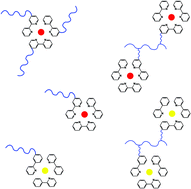The need for novel materials with luminescent properties and advanced processing features requires reliable and reproducible synthetic routes for the design of suitable materials, such as e.g. polypyridyl ruthenium(II) and iridium(III)-containing polymers. The most popular ligand for those purposes is the 4,4′-functionalized bipyridine unit. Therefore, several synthetic strategies for the derivatization of the 4,4′-dimethyl-2,2′-bipyridine are highlighted, and in particular functionalities, which enable further covalent linkage to polymeric structures, are discussed in this critical review. Subsequently, the different synthetic strategies for the preparation of polymeric metal-complexes are described, either starting from small functionalized complexes (later covalently attached to the polymer), or from macroligands (subsequently coordinated to the metal ions). The designed materials reveal good processing properties using spin coating and inkjet printing, as well as beneficial electro-optical properties for potential thin functional film applications, such as light-emitting electrochemical cells.

You have access to this article
 Please wait while we load your content...
Something went wrong. Try again?
Please wait while we load your content...
Something went wrong. Try again?


 Please wait while we load your content...
Please wait while we load your content...